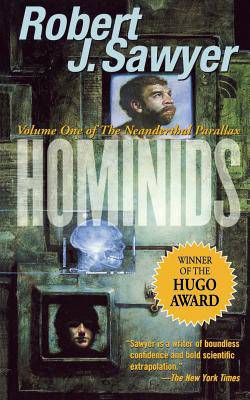
- Afhalen na 1 uur in een winkel met voorraad
- Gratis thuislevering in België vanaf € 30
- Ruim aanbod met 7 miljoen producten
- Afhalen na 1 uur in een winkel met voorraad
- Gratis thuislevering in België vanaf € 30
- Ruim aanbod met 7 miljoen producten
Zoeken
Omschrijving
Winner of the Hugo Award for Best Novel
Robert Sawyer's SF novels are perennial nominees for the Hugo Award, the Nebula Award, or both. Clearly, he must be doing something right since each one has been something new and different. What they do have in common is imaginative originality, great stories, and unique scientific extrapolation. His latest is no exception. Hominids is a strong, stand-alone SF novel, but it's also the first book of The Neanderthal Parallax, a trilogy that examines two unique species of people. They are alien to each other, yet bound together by the never-ending quest for knowledge and, beneath their differences, a common humanity. We are one of those species, the other is the Neanderthals of a parallel world where they, not Homo sapiens, became the dominant intelligence. In that world, Neanderthal civilization has reached heights of culture and science comparable to our own, but is very different in history, society, and philosophy. During a risky experiment deep in a mine in Canada, Ponter Boddit, a Neanderthal physicist, accidentally pierces the barrier between worlds and is transferred to our universe, where in the same mine another experiment is taking place. Hurt, but alive, he is almost immediately recognized as a Neanderthal, but only much later as a scientist. He is captured and studied, alone and bewildered, a stranger in a strange land. But Ponter is also befriended-by a doctor and a physicist who share his questing intelligence and boundless enthusiasm for the world's strangeness, and especially by geneticist Mary Vaughan, a lonely woman with whom he develops a special rapport. Meanwhile, Ponter's partner, Adikor Huld, finds himself with a messy lab, a missing body, suspicious people all around, and an explosive murder trial that he can't possibly win because he has no idea what actually happened. Talk about a scientific challenge! Contact between humans and Neanderthals creates a relationship fraught with conflict, philosophical challenge, and threat to the existence of one species or the other-or both-but equally rich in boundless possibilities for cooperation and growth on many levels, from the practical to the esthetic to the scientific to the spiritual. In short, Robert J. Sawyner has done it again.Specificaties
Betrokkenen
- Auteur(s):
- Uitgeverij:
Inhoud
- Aantal bladzijden:
- 448
- Taal:
- Engels
- Reeks:
Eigenschappen
- Productcode (EAN):
- 9780765392343
- Verschijningsdatum:
- 17/02/2003
- Uitvoering:
- Paperback
- Formaat:
- Trade paperback (VS)
- Afmetingen:
- 127 mm x 203 mm
- Gewicht:
- 480 g

Alleen bij Standaard Boekhandel
+ 80 punten op je klantenkaart van Standaard Boekhandel
Beoordelingen
We publiceren alleen reviews die voldoen aan de voorwaarden voor reviews. Bekijk onze voorwaarden voor reviews.











